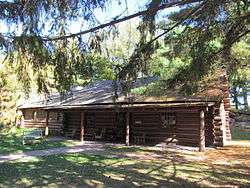Beach Lodge and Gallery

The Beach Gallery (44°22′26″N 73°13′59″W / 44.373832°N 73.233013°W) and Beach Lodge (44°22′27″N 73°13′58″W / 44.374149°N 73.232782°W) are two exhibit buildings at the Shelburne Museum in Shelburne, Vermont. They are both made from logs and are designed to resemble an Adirondack hunting camp. The Beach Lodge exhibits a large selection of hunting trophies (taxidermy), while the Beach Gallery exhibits art depicting the North American wilderness; this includes work by Carl Rungius (a hunting companion of Theodore Roosevelt), Arthur Fitzwilliam Tait, and Sydney Laurence.
History
In 1960, the Shelburne Museum commissioned the construction of the Beach Lodge and the Beach Gallery, named for William and Marie Beach, who were friends and hunting companions of Electra Havemeyer Webb, as well as Shelburne Museum patrons. Using timber forested at the Webb family’s Adirondack “great camp,” Nehasane, the Museum designed the Lodge and the Gallery to resemble an Adirondack hunting camp. To create an environment distinctly different from the rest of the grounds, the Museum excavated a shallow basin in which to build the two structures, surrounded the basin with Vermont sandstone, and planted spruce, hemlock, and cedar trees so that the area would resemble an Adirondack forest. [1]
In 2007 the Museum restored both the Beach Lodge and Gallery. The Lodge, whose original timber structure and interior remained in good condition, received basic renovations, while the Gallery, which had drastically deteriorated over the years, had to be razed. The Museum constructed a new cabin using logs from the timber left standing after a forest fire in Montana on the Gallery’s original floor plan. [2]
See also
- Shelburne Museum
- Taxidermy
- Trophy hunting
- Carl Rungius
- Arthur Fitzwilliam Tait
- Sydney Laurence
- Electra Havemeyer Webb
References
- ↑ Shelburne Museum. 1993. Shelburne Museum: A Guide to the Collections. Shelburne: Shelburne Museum, Inc.
- ↑ "Archived copy". Archived from the original on 2009-02-04. Retrieved 2009-03-26.